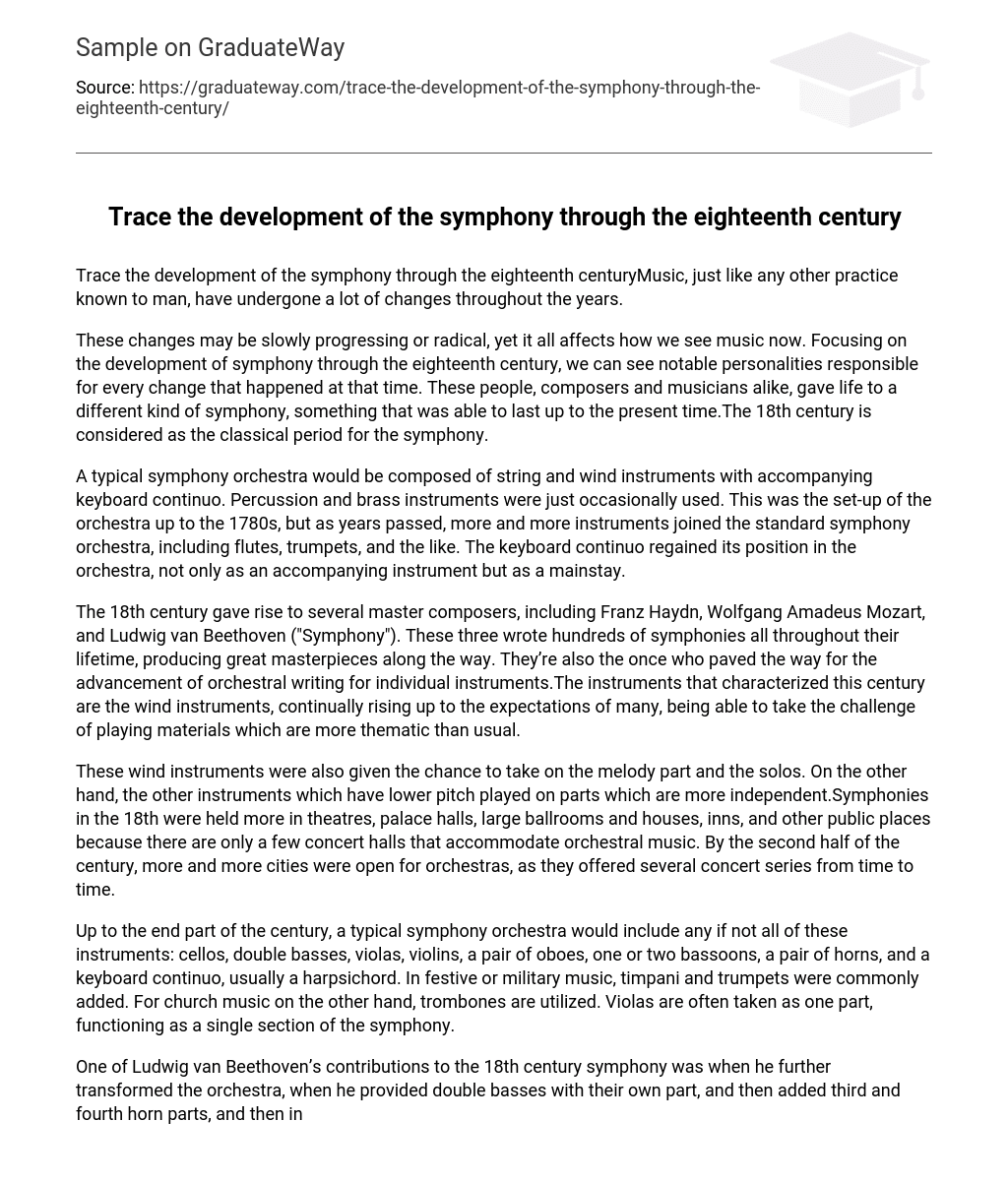Trace the development of the symphony through the eighteenth centuryMusic, just like any other practice known to man, have undergone a lot of changes throughout the years.
These changes may be slowly progressing or radical, yet it all affects how we see music now. Focusing on the development of symphony through the eighteenth century, we can see notable personalities responsible for every change that happened at that time. These people, composers and musicians alike, gave life to a different kind of symphony, something that was able to last up to the present time.The 18th century is considered as the classical period for the symphony.
A typical symphony orchestra would be composed of string and wind instruments with accompanying keyboard continuo. Percussion and brass instruments were just occasionally used. This was the set-up of the orchestra up to the 1780s, but as years passed, more and more instruments joined the standard symphony orchestra, including flutes, trumpets, and the like. The keyboard continuo regained its position in the orchestra, not only as an accompanying instrument but as a mainstay.
The 18th century gave rise to several master composers, including Franz Haydn, Wolfgang Amadeus Mozart, and Ludwig van Beethoven (“Symphony”). These three wrote hundreds of symphonies all throughout their lifetime, producing great masterpieces along the way. They’re also the once who paved the way for the advancement of orchestral writing for individual instruments.The instruments that characterized this century are the wind instruments, continually rising up to the expectations of many, being able to take the challenge of playing materials which are more thematic than usual.
These wind instruments were also given the chance to take on the melody part and the solos. On the other hand, the other instruments which have lower pitch played on parts which are more independent.Symphonies in the 18th were held more in theatres, palace halls, large ballrooms and houses, inns, and other public places because there are only a few concert halls that accommodate orchestral music. By the second half of the century, more and more cities were open for orchestras, as they offered several concert series from time to time.
Up to the end part of the century, a typical symphony orchestra would include any if not all of these instruments: cellos, double basses, violas, violins, a pair of oboes, one or two bassoons, a pair of horns, and a keyboard continuo, usually a harpsichord. In festive or military music, timpani and trumpets were commonly added. For church music on the other hand, trombones are utilized. Violas are often taken as one part, functioning as a single section of the symphony.
One of Ludwig van Beethoven’s contributions to the 18th century symphony was when he further transformed the orchestra, when he provided double basses with their own part, and then added third and fourth horn parts, and then incorporated trombone as a standard instrument in a symphony orchestra (“Symphony”).In the latter part of the century, around 1780s to 1790s, it was the first violinist who directed most orchestras (New York Philharmonic). In France however, baton conductors already started appearing. The evolution of symphony orchestra in France is somewhat different because they followed traditions of the past century, utilizing it up to the middle part of the century.
In the second half though, large orchestras in France resembled other classical orchestras all over Europe.When it comes to the roles of the instruments, the 18th century gave a constant part to most of the instruments used in the symphony. The early part of the century up to the 1780s gave similar parts to play for bassoons, cellos, double basses, and keyboard. The bassoons and cellos would occasionally be given obbligato passages, while the keyboard on the other hand, improves on harmonies above the bass.
Oboes and flutes were interchangeable in a symphony orchestra, wherein Oboists would often play the flute as well. Sometimes, they are also played simultaneously in a concert (Joichi).During the latter part of the century, at around 1780s and 1790s, more important roles in the symphony orchestra were carried by wind instruments. They were often used to introduce thematic material, as well as play solo passages.
Prior to this recognition, wind instruments were often used to double on the string parts or just alternated with them. The bass parts on the other hand, were separated into various independent parts for instruments like the cello, the bassoon, and the double bass. Throughout the century until the last quarter of the century, the role of the keyboard continuo gradually dwindled and faded. The uses of these instruments were also associated to various images, characters or scenes of a certain them, for example the trombone is associated with the underworld, or the clarinet with shepherds.
Music provided life to people back in the 18th century. Because of this, symphonies were given a great deal of importance and appreciation by a lot of people. Symphonies gave rise to different masters, continually changing the way we look at music. These changes may be radical or slow-progressing, but indeed, it was able to make a mark in the history of music, and we can all see and appreciate it even up to the present.
Works Cited:Joichi, Janet. “History of Symphony”. 2006. April 27 2009.
<http://symphony.calpoly.edu/History%20of%20Symphony/OrchestraHistory.html>.
New York Philharmonic. “A Short History of the Symphony Orchestra”. 1999. New York Philharmonic.
April 27 2009. <http://www.nyphilkids.org/lockerroom/history_f-r.
html>.”Symphony”. 2009. Encyclopædia Britannica.
Encyclopædia Britannica Online. April 27 2009. <http://www.britannica.com/EBchecked/topic/578021/symphony/27480/The-symphony-proper>.





